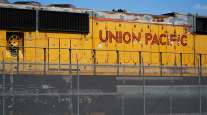Senior Reporter
Union Pacific Misses Q4 Earnings Estimate

[Stay on top of transportation news: Get TTNews in your inbox.]
Union Pacific Corp.’s 2019 fourth-quarter earnings missed Wall Street expectations, the Class I railroad reported Jan. 24.
Omaha, Neb.-based Union Pacific said net income was $1.40 billion or $2.03 a share, compared with $1.55 billion or $2.13 a share for the same period a year ago. The year-over-year quarterly share price is down 5%.
Wall Street analysts polled by FactSet were looking for earnings of $2.07 a share. Revenue was $5.21 billion, down 9.5% from a year ago, when the company reported revenue of $5.75 billion, and it was short of projections for $5.22 billion for the quarter.
Union Pacific $UNP Reports Fourth Quarter and Full Year 2019 Results https://t.co/96MBUDo1Wd — Union Pacific (@UnionPacific) January 23, 2020
Officials also disclosed on a conference call that they plan to reduce the number of employees, by as many as 3,000 in 2020, while running fewer but much longer trains. If that many employees retire or are laid off, the railroad will cut its head count by 8% this year after reducing staff by 11% in 2019.
Union Pacific is one of several railroads that is embracing the concept of precision-scheduling railroading, which is designed to lower costs and improve overall efficiency by increasing the number of freight cars that are moving in the system on fewer trains.
“Increasing train size remains one of our main areas of focus to utilize our existing network capacity, and we are making excellent progress,” Chief Operating Officer Jim Vena said. “By putting more product on fewer trains, we have increased train length across our system by 16% or over 1,100 feet since the fourth quarter of 2018 to approximately 8,200 feet in the fourth quarter of 2019.”
A train that length would be more than 1½ miles long.
For all of 2019, Union Pacific reported a net income of $5.91 billion compared with $5.96 billion last year, a decrease of 1%. On a per-share basis, the company said its annual figure was $8.38 per share in 2019, compared with $7.91 last year, an increase of 6%.
2019’s yearly operating revenue totaled $21.7 billion compared with $22.8 billion in 2018, a decrease of 5%.
“Given the challenging volume environment, we leveraged strong productivity to deliver solid financial results, including the third consecutive quarter with an operating ratio below 60%,” CEO Lance Fritz said.
In part one of a two-part exploration of autonomous technology today, our latest RoadSigns podcast revisits conversations with CEOs Alex Rodrigues of Embark and Cetin Mericli of Locomation. Hear them explain what testing automated trucks and developing platooning technology has taught them about the road ahead — and get new perspective with host commentary. Listen to a snippet from Rodrigues above, and to hear the full episode, go to RoadSigns.TTNews.com.
The railroad’s fourth-quarter operating ratio was 59.7 compared with 61.6 in 2019. For the year, the operating ratio improved to 60.6 from 62.7 in 2019. Operating ratio, or operating expenses as a percentage of revenue, is used to measure efficiency. The lower the ratio, the higher the company’s ability to generate profit.
“While we don’t anticipate a fuel tailwind like we experienced in 2019, we’re confident in our ability to achieve a sub-60.0 operating ratio. In fact, we believe we should close out 2020 with a full-year number that looks more like a 59,” Chief Financial Officer Jennifer Hamann said.
The company said by operating with fewer employees it will save an estimated $500 million this year.
“If our volume is flat this year, we’re going to have incremental employee productivity. If our volume grows, we will not add back resources at the same pace that we will grow,” Fritz said.
Union Pacific reported year-over-year decreases in three of four business lines.
Revenue from agricultural products declined 2% for the quarter to $1.099 billion compared with $1.124 billion in 2018. For the year, revenue in that sector fell 1%, to $4.44 billion from $4.46 billion in 2018.
Quarterly energy revenue saw a 25% year-over-year drop, to $838 million from $1.1 billion in 2018. For the entire year, energy revenue slipped 18%, to $3.76 billion from $4.6 billion in 2018.
Industrial freight in the fourth quarter remained flat year-to-year at $1.40 billion for 2019 and 2018. For the year, the sector showed a 2% increase, to $5.79 billion from $5.67 billion in 2018.
Premium freight declined 14% in the fourth quarter to $1.50 billion compared with $1.74 billion last year. For the year, the drop was 6% to $6.24 billion in 2019 from $6.62 billion last year.
Even with the numbers that missed expectations, company officials said they are cautiously optimistic 2020 will bring better earnings for the railroad.
“We need manufacturers in the industrial economy in the U.S. to gain a little bit more confidence and get their feet back under them in terms of capital investment and risk-taking,” Fritz said. “So there is a lot of moving parts there. It’s not one thing and, of course, those moving parts will change over the course of the year.”
Want more news? Listen to today's daily briefing:





